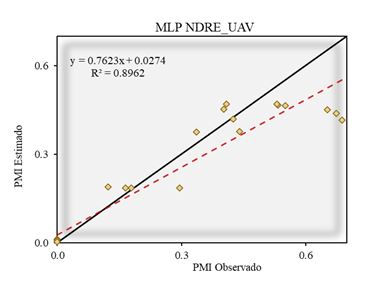Using neural networks for peanut maturity prediction with UAV images
DOI:
https://doi.org/10.52755/sas.v2iedesp2.129Keywords:
Digital Agriculture, Artificial Intelligence, Remote SensingAbstract
Remote sensing techniques and machine learning are important tools for the agricultural sector, and can bring significant improvements in agricultural management. In view of this, the objective was to create a method to predict peanut maturity from unmanned aerial vehicle
(UAV) images, using artificial neural networks (ANN). The experiment was conducted in a commercial field in the 2019/20 crop year in the municipality of Dumont - SP. The collection of images was obtained through the Micasense RedEdge multispectral camera. Two ANN models (RBF and MLP) were used to predict the peanut maturity index, with the spectral bands and 7 vegetation indices being used in the input layer. For validation of the models, 20% of the data were used and for training 80%. The NDRE was able to predict the PMI with accuracy (0.90 and 0.88) and precision (0.06 and 0.06) for the MLP and RBF networks respectively. The performance evaluation of the models indicates that the RBF and MLP networks are similar for predicting peanut maturity. It is concluded from this work that maturity index can be predicted using vegetation indices from UAV images.
Downloads

Downloads
Published
How to Cite
Issue
Section
License
Copyright (c) 2021 Jarlyson Brunno Costa Souza, Samira Luns Hatum de Almeida, Armando Lopes de Brito de Filho, Mirla Monteles, Leonardo Barbosa Silva, Rouverson Silva

This work is licensed under a Creative Commons Attribution-NonCommercial-ShareAlike 4.0 International License.
Autores concordam com os seguintes termos:
a) Os autores mantêm os direitos autorais e concedem à revista o direito de primeira publicação, com o trabalho simultaneamente licenciado sob a LicençaAttribution-NonCommercial-ShareAlike 4.0 International, que permite o compartilhamento do trabalho com reconhecimento da autoria e publicação inicial na Revista SAS. A licença permite o uso, a distribuição e a reprodução irrestrita, em qualquer meio, desde que devidamente citada a fonte. Essa licença permite também que outros remixem, adaptem e criem a partir do seu trabalho para fins não comerciais, desde que atribuam a você o devido crédito e que licenciem as novas criações sob termos idênticos.
b) Não cabe aos autores compensação financeira a qualquer título, por artigos ou resenhas publicados na South American Sciences.
c) Os conceitos expressos nos artigos publicados na South American Sciences são de inteira responsabilidade de seus autores.








